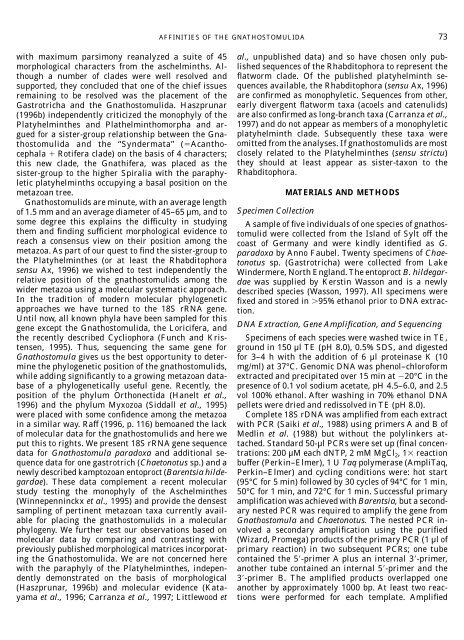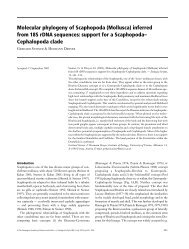Gnathostomulida—An Enigmatic Metazoan Phylum from both ...
Gnathostomulida—An Enigmatic Metazoan Phylum from both ...
Gnathostomulida—An Enigmatic Metazoan Phylum from both ...
Create successful ePaper yourself
Turn your PDF publications into a flip-book with our unique Google optimized e-Paper software.
with maximum parsimony reanalyzed a suite of 45<br />
morphological characters <strong>from</strong> the aschelminths. Although<br />
a number of clades were well resolved and<br />
supported, they concluded that one of the chief issues<br />
remaining to be resolved was the placement of the<br />
Gastrotricha and the Gnathostomulida. Haszprunar<br />
(1996b) independently criticized the monophyly of the<br />
Platyhelminthes and Plathelminthomorpha and argued<br />
for a sister-group relationship between the Gnathostomulida<br />
and the ‘‘Syndermata’’ (�Acanthocephala<br />
� Rotifera clade) on the basis of 4 characters;<br />
this new clade, the Gnathifera, was placed as the<br />
sister-group to the higher Spiralia with the paraphyletic<br />
platyhelminths occupying a basal position on the<br />
metazoan tree.<br />
Gnathostomulids are minute, with an average length<br />
of 1.5 mm and an average diameter of 45–65 µm, and to<br />
some degree this explains the difficulty in studying<br />
them and finding sufficient morphological evidence to<br />
reach a consensus view on their position among the<br />
metazoa. As part of our quest to find the sister-group to<br />
the Platyhelminthes (or at least the Rhabditophora<br />
sensu Ax, 1996) we wished to test independently the<br />
relative position of the gnathostomulids among the<br />
wider metazoa using a molecular systematic approach.<br />
In the tradition of modern molecular phylogenetic<br />
approaches we have turned to the 18S rRNA gene.<br />
Until now, all known phyla have been sampled for this<br />
gene except the Gnathostomulida, the Loricifera, and<br />
the recently described Cycliophora (Funch and Kristensen,<br />
1995). Thus, sequencing the same gene for<br />
Gnathostomula gives us the best opportunity to determine<br />
the phylogenetic position of the gnathostomulids,<br />
while adding significantly to a growing metazoan database<br />
of a phylogenetically useful gene. Recently, the<br />
position of the phylum Orthonectida (Hanelt et al.,<br />
1996) and the phylum Myxozoa (Siddall et al., 1995)<br />
were placed with some confidence among the metazoa<br />
in a similar way. Raff (1996, p. 116) bemoaned the lack<br />
of molecular data for the gnathostomulids and here we<br />
put this to rights. We present 18S rRNA gene sequence<br />
data for Gnathostomula paradoxa and additional sequence<br />
data for one gastrotrich (Chaetonotus sp.) and a<br />
newly described kamptozoan entoproct (Barentsia hildegardae).<br />
These data complement a recent molecular<br />
study testing the monophyly of the Aschelminthes<br />
(Winnepenninckx et al., 1995) and provide the densest<br />
sampling of pertinent metazoan taxa currently available<br />
for placing the gnathostomulids in a molecular<br />
phylogeny. We further test our observations based on<br />
molecular data by comparing and contrasting with<br />
previously published morphological matrices incorporating<br />
the Gnathostomulida. We are not concerned here<br />
with the paraphyly of the Platyhelminthes, independently<br />
demonstrated on the basis of morphological<br />
(Haszprunar, 1996b) and molecular evidence (Katayama<br />
et al., 1996; Carranza et al., 1997; Littlewood et<br />
AFFINITIES OF THE GNATHOSTOMULIDA<br />
al., unpublished data) and so have chosen only published<br />
sequences of the Rhabditophora to represent the<br />
flatworm clade. Of the published platyhelminth sequences<br />
available, the Rhabditophora (sensu Ax, 1996)<br />
are confirmed as monophyletic. Sequences <strong>from</strong> other,<br />
early divergent flatworm taxa (acoels and catenulids)<br />
are also confirmed as long-branch taxa (Carranza et al.,<br />
1997) and do not appear as members of a monophyletic<br />
platyhelminth clade. Subsequently these taxa were<br />
omitted <strong>from</strong> the analyses. If gnathostomulids are most<br />
closely related to the Platyhelminthes (sensu strictu)<br />
they should at least appear as sister-taxon to the<br />
Rhabditophora.<br />
MATERIALS AND METHODS<br />
Specimen Collection<br />
A sample of five individuals of one species of gnathostomulid<br />
were collected <strong>from</strong> the Island of Sylt off the<br />
coast of Germany and were kindly identified as G.<br />
paradoxa by Anno Faubel. Twenty specimens of Chaetonotus<br />
sp. (Gastrotricha) were collected <strong>from</strong> Lake<br />
Windermere, North England. The entoproct B. hildegardae<br />
was supplied by Kerstin Wasson and is a newly<br />
described species (Wasson, 1997). All specimens were<br />
fixed and stored in �95% ethanol prior to DNA extraction.<br />
DNA Extraction, Gene Amplification, and Sequencing<br />
Specimens of each species were washed twice in TE,<br />
ground in 150 µl TE (pH 8.0), 0.5% SDS, and digested<br />
for 3–4 h with the addition of 6 µl proteinase K (10<br />
mg/ml) at 37°C. Genomic DNA was phenol–chloroform<br />
extracted and precipitated over 15 min at �20°C in the<br />
presence of 0.1 vol sodium acetate, pH 4.5–6.0, and 2.5<br />
vol 100% ethanol. After washing in 70% ethanol DNA<br />
pellets were dried and redissolved in TE (pH 8.0).<br />
Complete 18S rDNA was amplified <strong>from</strong> each extract<br />
with PCR (Saiki et al., 1988) using primers A and B of<br />
Medlin et al. (1988) but without the polylinkers attached.<br />
Standard 50-µl PCRs were set up (final concentrations:<br />
200 µM each dNTP, 2 mM MgCl2,1�reaction buffer (Perkin–Elmer), 1 U Taq polymerase (AmpliTaq,<br />
Perkin–Elmer) and cycling conditions were: hot start<br />
(95°C for 5 min) followed by 30 cycles of 94°C for 1 min,<br />
50°C for 1 min, and 72°C for 1 min. Successful primary<br />
amplification was achieved with Barentsia, but a secondary<br />
nested PCR was required to amplify the gene <strong>from</strong><br />
Gnathostomula and Chaetonotus. The nested PCR involved<br />
a secondary amplification using the purified<br />
(Wizard, Promega) products of the primary PCR (1 µl of<br />
primary reaction) in two subsequent PCRs; one tube<br />
contained the 5�-primer A plus an internal 3�-primer,<br />
another tube contained an internal 5�-primer and the<br />
3�-primer B. The amplified products overlapped one<br />
another by approximately 1000 bp. At least two reactions<br />
were performed for each template. Amplified<br />
73








